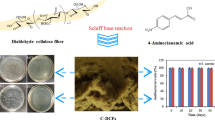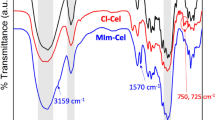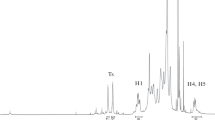Abstract
This study aims to develop a green and efficient method for synthesizing antimicrobial amino-functionalized microcrystalline celluloses from cotton fibers. Microcrystalline cellulose was prepared by acid hydrolyzing of cellulose. Tosyl cellulose was synthesized by tosylation of cellulose in an eco-friendly medium using NaOH/urea and decyl glucoside surfactant with DSTs of 0.51. Three amino-functionalized cellulose derivatives were synthesized by nucleophilic substitution reaction of tosyl cellulose with 3-aminopropyltrimethoylsilane, ethylenediamine, and triethylenetetramine. The physicochemical properties of investigated celluloses were characterized by Fourier transform infrared spectroscopy, X-ray diffraction analysis, scanning electron microscopy, and thermogravimetric analysis-differential scanning calorimetry. Microcrystalline cellulose with high crystallinity index (81.90%) and crystalline size of 0.30 nm was isolated from cotton fibers. After the dissolution and chemical modification, the crystalline form of cellulose was transformed from cellulose I to amorphous cellulose II. The thermal degradation of aminated cellulose was around 260 °C. The amino cellulose exhibited high inhibition activity against S. aureus, P. aeruginosa, and E. coli with MIC values less than 5 mg mL–1. The chemical modification of surface cellulose could deliver antimicrobial cellulosic materials with potential applications for air and water treatments or as ingredients in the food, cosmetic, and pharmaceutical industries.






Similar content being viewed by others
Availability of data and material
Not applicable.
Code availability
Not applicable.
References
Sperandeo P, Bosco F, Clerici F, Polissi A, Gelmi ML, Romanelli A (2020) Covalent grafting of antimicrobial peptides onto microcrystalline cellulose. ACS Appl Bio Mater 3:4895–4901. https://doi.org/10.1021/acsabm.0c00412
Tavakolian M, Jafari SM, van de Ven TGM (2020) A review on surface-functionalized cellulosic nanostructures as biocompatible antibacterial materials. Nano-Micro Lett 12:1–23. https://doi.org/10.1007/s40820-020-0408-4
Ullah H, Wahid F, Santos HA, Khan T (2016) Advances in biomedical and pharmaceutical applications of functional bacterial cellulose-based nanocomposites. Carbohydr Polym 150:330–352. https://doi.org/10.1016/j.carbpol.2016.05.029
Hong L, Wang YL, Jia SR, Huang Y, Gao C, Wan YZ (2006) Hydroxyapatite/bacterial cellulose composites synthesized via a biomimetic route. Mater Lett 60:1710–1713. https://doi.org/10.1016/j.matlet.2005.12.004
El-Sayed NS, El-Sakhawy M, Brun N, Hesemann P, Kamel S (2018) New approach for immobilization of 3-aminopropyltrimethoxysilane and TiO2 nanoparticles into cellulose for BJ1 skin cells proliferation. Carbohydr Polym 199:193–204. https://doi.org/10.1016/j.carbpol.2018.07.004
Haldar D, Purkait MK (2020) Micro and nanocrystalline cellulose derivatives of lignocellulosic biomass: a review on synthesis, applications and advancements. Carbohydr Polym 250:116937. https://doi.org/10.1016/j.carbpol.2020.116937
Trache D, Hussin MH, Hui Chuin CT, Sabar S, Fazita MRN, Taiwo OFA, Hassan TM, Haafiz MKM (2016) Microcrystalline cellulose: isolation, characterization and bio-composites application—a review. Int J Biol Macromol 93:789–804. https://doi.org/10.1016/j.ijbiomac.2016.09.056
Shi S, Zhang M, Ling C, Hou W, Yan Z (2018) Extraction and characterization of microcrystalline cellulose from waste cotton fabrics via hydrothermal method. Waste Manag 82:139–146. https://doi.org/10.1016/j.wasman.2018.10.023
D.D. Fang, Cotton fiber: physics, chemistry and biology, 2018. https://doi.org/10.1007/978-3-030-00871-0.
Fu F, Li L, Liu L, Cai J, Zhang Y, Zhou J, Zhang L (2015) Construction of cellulose based ZnO nanocomposite films with antibacterial properties through one-step coagulation. ACS Appl Mater Interfaces 7:2597–2606. https://doi.org/10.1021/am507639b
Singla R, Soni S, Patial V, Kulurkar PM, Kumari A, Mahesh S, Padwad YS, Yadav SK (2017) Cytocompatible anti-microbial dressings of syzygium cumini cellulose nanocrystals decorated with silver nanoparticles accelerate acute and diabetic wound healing. Sci Rep 7:1–13. https://doi.org/10.1038/s41598-017-08897-9
Rieger KA, Cho HJ, Yeung HF, Fan W, Schiffman JD (2016) Antimicrobial activity of silver ions released from zeolites immobilized on cellulose nanofiber mats. ACS Appl Mater Interfaces 8:3032–3040. https://doi.org/10.1021/acsami.5b10130
Li W, Li X, Wang Q, Pan Y, Wang T, Wang H, Song R, Deng H (2014) Antibacterial activity of nanofibrous mats coated with lysozyme-layered silicate composites via electrospraying. Carbohydr Polym 99:218–225. https://doi.org/10.1016/j.carbpol.2013.07.055
Zhu K, Ye T, Liu J, Peng Z, Xu S, Lei J, Deng H, Li B (2013) Nanogels fabricated by lysozyme and sodium carboxymethyl cellulose for 5-fluorouracil controlled release. Int J Pharm 441:721–727. https://doi.org/10.1016/j.ijpharm.2012.10.022
He L, Liang H, Lin L, Shah BR, Li Y, Chen Y, Li B (2015) Green-step assembly of low density lipoprotein/sodium carboxymethyl cellulose nanogels for facile loading and pH-dependent release of doxorubicin. Colloids Surfaces B Biointerfaces 126:288–296. https://doi.org/10.1016/j.colsurfb.2014.12.024
Sobhana SSL, Bogati DR, Reza M, Gustafsson J, Fardim P (2016) Cellulose biotemplates for layered double hydroxides networks. Microporous Mesoporous Mater 225:66–73. https://doi.org/10.1016/j.micromeso.2015.12.009
Feese E, Sadeghifar H, Gracz HS, Argyropoulos DS, Ghiladi RA (2011) Photobactericidal porphyrin-cellulose nanocrystals: synthesis, characterization, and antimicrobial properties. Biomacromolecules 12(10):3528–3539. https://doi.org/10.1021/bm200718s
Fernandes SCM, Sadocco P, Alonso-Varona A, Palomares T, Eceiza A, Silvestre AJD, Mondragon I, Freire CSR (2013) Bioinspired antimicrobial and biocompatible bacterial cellulose membranes obtained by surface functionalization with aminoalkyl groups. ACS Appl Mater Interfaces 5:3290–3297. https://doi.org/10.1021/am400338n
Maimaiti H, Awati A, Yisilamu G, Zhang D, Wang S (2019) Synthesis and visible-light photocatalytic CO 2 /H 2 O reduction to methyl formate of TiO 2 nanoparticles coated by aminated cellulose. Appl Surf Sci 466:535–544. https://doi.org/10.1016/j.apsusc.2018.10.070
Saini S, Belgacem N, Mendes J, Elegir G, Bras J (2015) Contact antimicrobial surface obtained by chemical grafting of microfibrillated cellulose in aqueous solution limiting antibiotic release. ACS Appl Mater Interfaces 7:1–27. https://doi.org/10.1021/acsami.5b04938
Heinze T, Rahn K (1997) Cellulose-p-toluenesulfonates: a valuable intermediate in cellulose chemistry. Macromol Symp 120:103–113. https://doi.org/10.1002/masy.19971200112
Schmidt S, Liebert T, Heinze T (2014) Synthesis of soluble cellulose tosylates in an eco-friendly medium. Green Chem 16:1941–1946. https://doi.org/10.1039/c3gc41994k
Heinze T, Genco T, Petzold-Welcke K, Wondraczek H (2012) Synthesis and characterization of aminocellulose sulfates as novel ampholytic polymers. Cellulose 19:1305–1313. https://doi.org/10.1007/s10570-012-9725-1
EL-Sayed NS, El-Ziaty AK, El-Meligy MG, Nagieb ZA (2017) Syntheses of new antimicrobial cellulose materials based 2-((2-aminoethyl)amino)-4-aryl-6-indolylnicotinonitriles. Egypt J Chem 60:465–477. https://doi.org/10.21608/ejchem.2017.3375
Nazir F, Iqbal M (2020) Synthesis, characterization and cytotoxicity studies of aminated microcrystalline cellulose derivatives against melanoma and breast cancer cell lines. Polymers (Basel) 12:1–20. https://doi.org/10.3390/polym12112634
Elchinger PH, Faugeras PA, Zerrouki C, Montplaisir D, Brouillette F, Zerrouki R (2012) Tosylcellulose synthesis in aqueous medium. Green Chem 14:3126–3131. https://doi.org/10.1039/c2gc35592b
Gericke M, Schaller J, Liebert T, Fardim P, Meister F, Heinze T (2012) Studies on the tosylation of cellulose in mixtures of ionic liquids and a co-solvent. Carbohydr Polym 89:526–536. https://doi.org/10.1016/j.carbpol.2012.03.040
Tarchoun AF, Trache D, Klapötke TM, Derradji M, Bessa W (2019) Ecofriendly isolation and characterization of microcrystalline cellulose from giant reed using various acidic media. Cellulose 26:7635–7651. https://doi.org/10.1007/s10570-019-02672-x
Tarchoun AF, Trache D, Klapötke TM, Krumm B, Mezroua A, Derradji M, Bessa W (2021) Design and characterization of new advanced energetic biopolymers based on surface functionalized cellulosic materials. Cellulose 0123456789:6107–6123. https://doi.org/10.1007/s10570-021-03965-w
Tarchoun AF, Trache D, Klapötke TM, Belmerabet M, Abdelaziz A, Derradji M, Belgacemi R (2020) Synthesis, characterization, and thermal decomposition kinetics of nitrogen-rich energetic biopolymers from aminated giant reed cellulosic fibers. Ind Eng Chem Res 59:22677–22689. https://doi.org/10.1021/acs.iecr.0c05448
Tarchoun AF, Trache D, Klapötke TM, Krumm B (2020) New insensitive nitrogen-rich energetic polymers based on amino-functionalized cellulose and microcrystalline cellulose: synthesis and characterization. Fuel 277:118258. https://doi.org/10.1016/j.fuel.2020.118258
Rashid M, Gafur MA, Sharafat MK, Minami H, Miah MAJ, Ahmad H (2017) Biocompatible microcrystalline cellulose particles from cotton wool and magnetization via a simple in situ co-precipitation method. Carbohydr Polym 170:72–79. https://doi.org/10.1016/j.carbpol.2017.04.059
El-Sayed NS, El-Sakhawy M, Hesemann P, Brun N, Kamel S (2018) Rational design of novel water-soluble ampholytic cellulose derivatives. Int J Biol Macromol 114:363–372. https://doi.org/10.1016/j.ijbiomac.2018.03.147
Zhang L, Yan P, Li Y, He X, Dai Y, Tan Z (2020) Preparation and antibacterial activity of a cellulose-based Schiff base derived from dialdehyde cellulose and L-lysine. Ind Crops Prod 145:112126. https://doi.org/10.1016/j.indcrop.2020.112126
Trask BJ, Drake GL, Margavio MF, Drake GL Jr, Margavio MF (1987) Thermal properties of tritylated and tosylated cellulose. J Appl Polym Sci 33:2317–2331. https://doi.org/10.1002/app.1987.070330705
El Hamdaoui L, Talbaoui A, El Moussaouiti M (2021) Nucleophilic displacement reaction on tosyl cellulose by L-methionine to the synthesis of novel water-soluble cellulose derivative and its antibacterial activity. Int J Polym Sci 2021:6613684. https://doi.org/10.1155/2021/6613684
Zhang L, Ge H, Xu M, Cao J, Dai Y (2017) Physicochemical properties, antioxidant and antibacterial activities of dialdehyde microcrystalline cellulose. Cellulose 24:2287–2298. https://doi.org/10.1007/s10570-017-1255-4
Rabea EI, Badawy MET, Stevens CV, Smagghe G, Steurbaut W (2003) Chitosan as antimicrobial agent: applications and mode of action. Biomacromol 4:1457–1465. https://doi.org/10.1021/bm034130m
Hu L, Meng X, Xing R, Liu S, Chen X, Qin Y, Yu H, Li P (2016) Design, synthesis and antimicrobial activity of 6-N-substituted chitosan derivatives, Bioorganic Med. Chem Lett 26:4548–4551. https://doi.org/10.1016/j.bmcl.2015.08.047
Mohamed NA, El-Ghany NAA, Fahmy MM (2016) Novel antimicrobial superporous cross-linked chitosan/pyromellitimide benzoyl thiourea hydrogels. Int J Biol Macromol 82:589–598. https://doi.org/10.1016/j.ijbiomac.2015.09.023
Lin L, Gu Y, Li C, Vittayapadung S, Cui H (2018) Antibacterial mechanism of ε-Poly-lysine against Listeria monocytogenes and its application on cheese. Food Control 91:76–84. https://doi.org/10.1016/j.foodcont.2018.03.025
Bo T, Han PP, Su QZ, Fu P, Guo FZ, Zheng ZX, Tan ZL, Zhong C, Jia SR (2016) Antimicrobial ε-poly-l-lysine induced changes in cell membrane compositions and properties of Saccharomyces cerevisiae. Food Control 61:123–134. https://doi.org/10.1016/j.foodcont.2015.09.018
Shih IL, Shen MH, Van YT (2006) Microbial synthesis of poly(ε-lysine) and its various applications. Bioresour Technol 97:1148–1159. https://doi.org/10.1016/j.biortech.2004.08.012
Funding
This research is funded by the Graduate University of Science and Technology under grant number GUST.STS.ĐT2018-HH03.
Author information
Authors and Affiliations
Contributions
Minh Huy Do: investigation and writing—orginal draft. Thi Khanh Van Khuat: writing—review and editing and supervison. Phuong Thanh Huynh: investigation. Luu Nhat Tan Nguyen: investigation. Bich Hang Do: investigation and writing—review and editing. Phuoc Dien Pham: validation and writing—review and editing. Dinh Hiep Nguyen: writing—review and editing. Hien Minh Nguyen: writing—review and editing. Ut Dong Thach: conceptualization, writing—orginal draft, methodology, and funding acquisition.
Corresponding author
Ethics declarations
Ethics approval
Not applicable.
Consent to participate
Not applicable.
Consent for publication
Not applicable.
Conflict of interest
The authors declare no competing interests.
Additional information
Publisher's note
Springer Nature remains neutral with regard to jurisdictional claims in published maps and institutional affiliations.
Supplementary Information
Below is the link to the electronic supplementary material.
Rights and permissions
About this article
Cite this article
Do, M.H., Van Thi Khuat, K., Huynh, P.T. et al. Synthesis, characterization, and antibacterial activity of amino-functionalized microcrystalline cellulose derivatives from cotton fibers. Biomass Conv. Bioref. 13, 10595–10603 (2023). https://doi.org/10.1007/s13399-022-02391-7
Received:
Revised:
Accepted:
Published:
Issue Date:
DOI: https://doi.org/10.1007/s13399-022-02391-7




